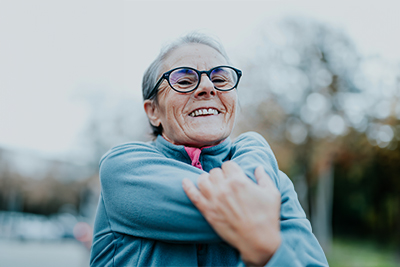
Staying active well into your 80s and beyond
Embracing regular physical activity can help you feel healthy, agile, and full of energy. If you’re looking to add more movement to your routine or explore new activities, here are our top tips on how to lead an active, vibrant, and healthy life.
“Start where you are. Use what you have. Do what you can.” – Arthur Ashe
Why being physically active matters as you age
Keeping on track with regular movement and resistance work can help to improve your muscle strength, balance, and coordination plus protect bone density, which reduces the risk of falls and fractures. The best part about staying active is any amount of physical movement promotes the release of endorphins, which provides you with an overall better sense of well-being.
How much physical activity do I need?
The guidelines for physical activity among older Australians (65 years and older) from the Department of health and Aged Care suggest engaging in daily activity in various ways, encompassing fitness, strength, balance, and flexibility exercises. It’s recommended to strive for at least 30 minutes of moderate-intensity physical activity on most, if not, all days.
Handy tips for moving more
Before taking on any new exercise regimen, it’s advisable to consult with your GP or another qualified health professional to ensure you have the green light to proceed, especially if you have any pre-existing health conditions or injuries.
Learn simple exercises for at-home fitness:
Stay active without stepping outside by mastering a few convenient and gentle moves you can do at home. Activities such as:
- Chair stands – Also known as a chair rise or chair stand, this sit-to-stand exercise involves sitting down and standing up from a seat without using your hands for assistance. It helps to improve strength and balance in muscles that help you sit down and stand up.
- Balancing on one foot (with support from a kitchen bench) – Every time you practice the one-leg stance, it is an opportunity to recalibrate your brain, forming new connections and strengthening the coordination between your ears, eyes, joints, and muscles. Sensors in all our joints and muscles keep sending feedback to the brain so it can learn how best to keep you upright.
- Bicep curls using canned food – Soup cans are an excellent substitute for light hand weights! Since they are not as heavy as a weight you might normally exercise with, we can incorporate some static holds or small bounces to help intensify the exercise. This workout is mainly going to focus on the upper body, with a few lower-body moves. It’s perfect for when you don’t want a super intense workout but still want to get your body moving.
- Side leg raises – This one is so simple and can be incorporated into your daily routine. Simply stand upright with your toes facing forward. As you lift your right leg off the floor with the foot flexed, inhale and shift the weight onto your left foot. As you exhale, bring the leg back down to meet the left.
Connect with your community:
Many gyms, senior citizen centres, neighbourhood centres, and local councils hold fitness programs for older adults. Engaging in these programs allows you to exercise alongside people in your age group and make new friends.
Embrace walking:
Among older adults, walking stands out as a beloved form of exercise, promoting muscle strength, joint health, weight management, and balance. Improve your walking routine by exploring new areas or routes each week, incorporating walks into out-of-town excursions, joining a walking club, or by starting up a walking group with friends.
Need more tips?
Read more about the types of activities recommended for seniors and what types of wellness activity programs we have available at St Agnes retirement villages.
For more information about our retirement villages and available villas, please get in touch with us.
